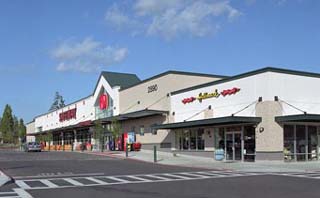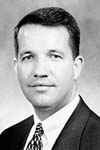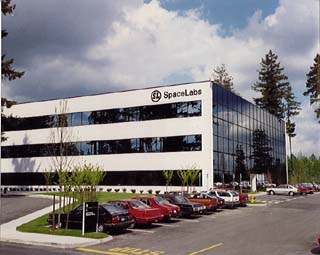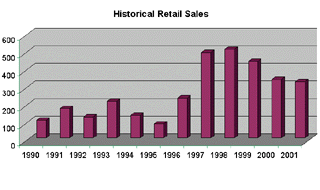
Surveys
DJC.COM
February 28, 2002
What’s in store for investors in 2002
CB Richard Ellis

Photos courtesy of CB Richard Ellis Sales of retail buildings faired much better than those of offices. One of 2001’s notable retail sales was Silverdale Plaza for $22.75 million. |
What will 2002 hold for the office and retail markets?
To get a better idea, we must first look back at 2001 to see why the office market didn’t hold up as well as the retail market.
Office
Last year was one of transition in the investment market.
The national recession, coupled with local economic woes, caused office sales to plummet by almost two thirds, from a high of $1.3 billion in sales in 1998 to $448 million of sales in 2001. Interestingly, this 2001 sales volume was similar to 1996.

Fosseen |

Senini |
A gap in pricing between sellers and buyers continued to grow during the year as buyers tried to determine true market rents. This was best illustrated by the lack of trades and the large number of office properties offered to market and later withdrawn by the sellers.
Ten major projects were taken off the market. These included: The Bank of California building, the Exchange building, the Plaza at Yarrow Bay, the Martin Selig portfolio, First and Stewart, Waterfront Place Tower, Washington Park in Bellevue, the Delphi Building, the ABAM building and Washington Park I & II in Federal Way.
User sales, wherein a user purchases a building rather than an investor, were weak save two huge purchases by Microsoft, the $142 million purchase of Lakeridge Square and the purchase of SpaceLab’s campus for $74 million.
What will 2002 bring?
With continued flat rental rates, we believe sales levels will be similar to 2001. Opportunity buyers will continue to scour the market looking for quality real estate priced below replacement costs. Conservative buyers, made up of pension fund advisors and high net worth individuals, will continue to seek well-located properties and triple-net long-term leased investments. Both buyer types see this down cycle as an opportunity to buy in desirable markets, like downtown Seattle and Bellevue, where product is difficult to find in most other times.
Many owners will continue to hold properties, refinancing rather than selling, waiting for rents to return to 2000 levels and sales prices to rise once again.

CREDIT HERE Microsoft’s purchase of SpaceLab’s campus for $74 million was one of only two large transactions last year in the weak market for user sales. The other was Microsoft’s purchase of Lakeridge Square for $142 million. |
Retail
The retail market did not suffer like the office market did in 2001. Sales levels were near 2000 levels, with $319 million sold in 2001 versus $333 million sold in 2000, and demand continued to be strong.
Lack of available product resulted in strong competition for most properties. Notable sales were The Commons at Issaquah trading for $42 million, Silverdale Plaza for $22.75 million, and Island Village for $15.75 million.
P. O’B. Montgomery & Co. purchased most of the defunct Burnham Pacific portfolio in the area, including: Greentree Plaza, Fairwood Square, Park Manor and a portion of James Village.
The tragic events of Sept. 11 and the nationwide recession caused investors to change purchasing criteria, narrowing their buying focus to grocery-anchored centers and single-tenant triple-net properties leased to Fortune 500 companies.
A good example of this was the active trading of Walgreens drug stores. Prior to Sept. 11, eight Walgreens had been on the market for six months, some even longer. After Sept. 11, all were under contract or had been sold. Today, Walgreens are highly sought after; prices are higher with cap rates lower due to the strong demand for credit tenants.
This year will be a lot like 2001, with similar sales volumes. Purchasers will continue to seek grocery-anchored centers, single-tenant triple-net properties and infill redevelopment opportunities.

Courtesy of CB Richard Ellis |
Like the office arena, purchasers will see this down cycle as an opportunity to buy in locations where product is difficult to find in most other times. Prices for well located, quality real estate will rise, bucking the trend of most trades. Grocery-anchored centers and triple-net properties will receive much attention and should be widely marketed in a controlled process to achieve highest prices with a pre-qualified buyer.
Private and periodic buyers, such as the 1031 exchange buyer, will remain much more active than the institutional buyer.
There will be activity in 2002, however it will be focused on quality retail and office buildings and opportunity purchases in the retail arena.
Don Fosseen is vice president and Lou Senini is senior associate of the Seattle Investment Properties Group of CB Richard Ellis. The group represents owners in property dispositions and select buyers in property acquisitions. It also provides consultation for other financial and business decisions.
Other Stories:
- Recession? Don’t worry, it’s just a cycle
- Leasehold title insurance: New ALTA endorsements
- 4,000 hours of training to change a light switch?
- Market grows for affordable assisted living
- Beer distributor serves up Arlington
- 2,158 reasons to like nonprofit housing groups
- Regulation reform can help jump-start the region
- Condo legislation creates legal slugfest
- A tale of two cities’ downtowns
- Managing churn without feeling the burn
- Workplace design can improve productivity
- Spokane: A study in steady growth
- Work-site schools teach a lesson to developers
Copyright ©2009 Seattle Daily Journal and DJC.COM.
Comments? Questions? Contact us.